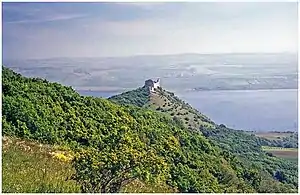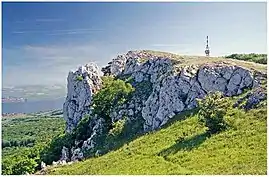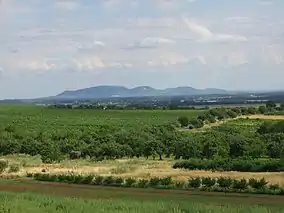Pálava Protected Landscape Area
The Pálava Protected Landscape Area (Czech: Chráněná krajinná oblast Pálava, abbreviated CHKO Pálava) is a protected landscape area and a UNESCO biosphere reserve located in Moravia in the Czech Republic, on the border with Austria. The highest point is Děvín with its 549 m a.s.l. This unique area was originally recognized by UNESCO in 1986 and expanded in 2003 to include another UNESCO site, the Lednice–Valtice Cultural Landscape. CHKO Pálava is dominated by the limestone Pálava Hills (part of the outer Western Carpathians), and contains a significant proportion of natural or little affected steppe ecosystems that include meadow steppe, forest steppe, and thermophilic oak forest. In the floodplain of the river Thaya, forests alternate with meadows and wetland habitat that also include halophytic vegetation. The remaining part of CHKO Pálava is used agriculturally, with many sustainably farmed vineyards that are a part of the wine subregion Mikulovská. CHKO Pálava contains well-preserved monuments of historical significance, such as the Paleolithic site in Dolní Věstonice where the Venus of Dolní Věstonice, a ceramic Venus figurine dating to 29,000–25,000 BCE, was discovered. Mikulov, a town founded in the Middle Ages, is located in the southernmost part of CHKO Pálava, and contains buildings of historical and architectural significance, such as Mikulov Castle.
 Děvičky Castle ruins over Nové Mlýny Reservoir
Děvičky Castle ruins over Nové Mlýny Reservoir Děvín
Děvín Orphan Castle (Sirotčí hrádek) ruins
Orphan Castle (Sirotčí hrádek) ruins Holy Hill (Svatý kopeček) over Mikulov
Holy Hill (Svatý kopeček) over Mikulov
| Pálava | |
|---|---|
 Pálava from the northwest | |
| Location | Břeclav, South Moravian, Czech Republic |
| Area | 83 km2 (32 sq mi) |
| Established | 1976-03-19 |
| Operator | Správa CHKO Pálava |
| Website | www.palava.ochranaprirody.cz |